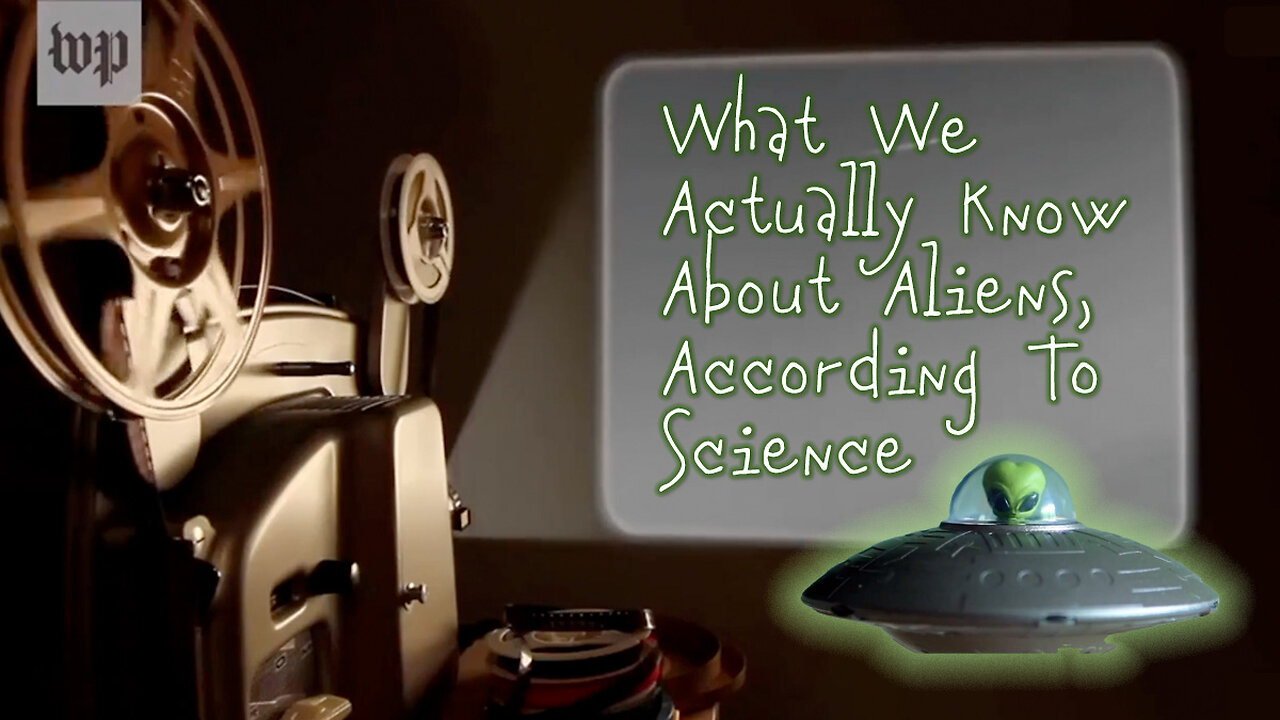Premium Only Content

What We Actually Know About Aliens, According To Science (The Washington Post)
What We Actually Know About Aliens, According To Science
By Joel Achenbach
The Washington Post
November 25, 3023
GREEN BANK, W.Va. — It came from space, hurtling at tremendous speed: a mystery object, reddish, rocky, shaped like a cigar. Its velocity was so extreme it had to have come from somewhere far away, in the interstellar realm. The astronomers in Hawaii who spotted it in 2017 named it 'Oumuamua, Hawaiian for "a messenger from afar arriving first."
But what was it, exactly? A comet? An asteroid?
Or maybe … an alien spacecraft?
That conjecture incited headlines, as well as eyerolls from most scientists. But here in West Virginia, the people involved in the search for extraterrestrial intelligence -- commonly called SETI -- decided to aim a giant radio telescope at it, just to be sure.
Aliens are having a moment. Fascination with the concept of extraterrestrial visitors isn't new, but it has enjoyed a 21st-century efflorescence. Military pilots have seen things that look otherworldly. The Pentagon has established an office to look into the sightings. Congress has held hearings. Even NASA got into the game, training the cool logic of science onto a scorching-hot cultural topic.
Somewhere along the line, UFOs got rebranded. Unidentified flying objects are now, per government edict, unidentified anomalous phenomena (UAPs).
For SETI researchers, the hypothetical existence of aliens is foundational. Nestled in the remote mountain town of Green Bank, the National Radio Astronomy Observatory has a role in one of the most ambitious SETI projects, called Breakthrough Listen. The project buys time on the towering Robert C. Byrd Green Bank Telescope, which has a steerable dish 300 feet in diameter. If there are aliens transmitting radio signals anywhere near us in the galaxy, that big dish is all ear.
Confirming an alien radio signal would be possibly the most consequential and disruptive scientific discovery of all time. SETI scientists have no doubt that the search is worth the effort.
"I think if we didn't do that, and turned our back on our cosmological neighbors, that would be a sad thing for me," David MacMahon, the chief scientist on Breakthrough Listen, said this fall during a visit to Green Bank.
That's why the Breakthrough Listen team pointed the big telescope at the mystery object 'Oumuamua, listening for signs of intelligent life.
"It was absolutely silent," reports Matt Lebofsky, lead engineer on the project.
Silence: That is all astronomers have heard since the first SETI search was conducted at Green Bank in 1960.
Only a small fraction of our galaxy has been studied. Absence of evidence, as everyone knows, is not evidence of absence. Aliens may not consider radio waves to be a useful or dignified way to communicate. They could be pathologically shy. Or, at least with the kind of technology we have today, they could be just a little bit out of range.
For whatever reason, SETI has not found anyone out there, and at some point the silence could get deafening.
The physicist Paul Davies has written that SETI is a search for a needle in a haystack without knowing if the needles are really there.
All possibilities remain in play. Including the possibility that we are alone.
UAPs and the renewed alien obsession
One day circa 1950, the physicist Enrico Fermi was talking with fellow scientists about flying saucers and whether it might be possible, in theory, for an advanced alien species to cross the vast expanses of the galaxy by traveling faster than the speed of light.
Suddenly Fermi erupted: "But where is everybody?"
Thus was born "the Fermi Paradox." The universe is big and old, and it is highly plausible that alien civilizations have evolved, based purely on statistical probabilities. Fermi posed his question in an era of technological revolutions, including computers and rocketry. It seemed possible humans would master space travel and explore the cosmos. So why, he asked, is there no compelling scientific evidence that extraterrestrials have visited Earth?
Perhaps the simplest explanation for the Fermi Paradox is that there's no paradox at all: They're here!
The idea that mysterious things seen in the sky are alien spaceships has proved remarkably resilient. It has had some ups and downs and is now in an up phase. It has found a warm reception recently in the halls of Congress, where the hypothesis has enjoyed bipartisan support amid a push for government disclosure of whatever anyone might know about extraterrestrials.
"The American public has a right to learn about technologies of unknown origins, non-human intelligence, and unexplainable phenomena," Senate Majority Leader Charles E. Schumer (D-N.Y.) said this summer.
Republicans in the House convened a headline-grabbing hearing in July at which a former Air Force intelligence officer testified that he had been told that the United States is in possession not only of crashed spacecraft of "non-human" origin but also alien "biologics." This is a relaunch of the 1947 Roswell, N.M., crashed-saucer story, rising Lazarus-like to annoy skeptics anew.
In September, a journalist in Mexico garnered global headlines by displaying to Mexico's Congress what he claimed were the thousand-year-old mummified corpses of two three-fingered aliens. Mexican scientists scoffed, appalled at the reputational damage caused by what one professor called "a pseudoscientific event, which appeals to our fantasies, desires, and fears."
The scientific community views the recent UAP mania as a cultural phenomenon, not an astrobiological one. There's not much here that meets the standards science requires, such as evidence that is testable, reproducible, falsifiable.
That's impossible with the conjectured existence of alien spaceships that have the amazing ability to disappear. And if someone says there's alien hardware stashed in a warehouse somewhere, scientists want to see it, and poke and prod it and bite it and gnaw on it for a while.
There have been many sightings of UAPs by credible witnesses, including military pilots. Some remain unexplained and could have national security significance if the objects in question involve new technologies from foreign adversaries. But official government reports -- including one from a special NASA task force -- say there is no evidence that any of these things involve extraterrestrials.
SETI researchers occupy a unique and awkward niche amid the debate. Aliens, though hypothetical, are the reason they go to work. But they have chosen not to include an investigation of blurry, stealthy, here-and-gone UAPs as part of their mission, MacMahon said.
"SETI is not a belief system," MacMahon said. "It's a scientific methodology."
The math that says Earth is no miracle
For SETI experts, two arguments grounded in science bolster the conjecture that aliens are surely out there somewhere: Big Numbers and the Copernican principle.
The Big Numbers argument notes that our galaxy, the Milky Way, has something like 400 billion stars, and it's just one of untold billions of galaxies in a universe that might be infinite. Moreover, in the past 30 years, astronomers have discovered that planets of all shapes and sizes are common in the universe.
With so much turf out there, even the most frowny-faced skeptic must admit it's hard to run the numbers in a 13.8 billion-year-old universe like ours and wind up with just one self-aware, technological, telescope-constructing species.
The Copernican principle is inspired by 16th-century astronomer Copernicus, whose revolutionary model of the solar system put the sun and not Earth at the center. The principle suggests that, in the same way that Earth is not in a privileged place in the universe, humanity should not presume itself special, or unique. The universe is not about us, and what happened on this planet over the past 4 billion years could happen elsewhere.
"Otherwise you have to believe that Earth is a miracle. I don't," said Seth Shostak, an astronomer at the SETI Institute in Mountain View, Calif. "It's just never true that you only find one example of something in nature."
Shostak is right, with an asterisk: So far, science has found only one example of a habitable planet with intelligent life. Despite decades of hunting for signs of another civilization, in scientific parlance, N=1.
In 1960, here in Green Bank, radio astronomer Frank Drake made the first attempt to pick up alien signals, aiming a telescope at two nearby sun-like stars. "Project Ozma" produced one brief false alarm, but otherwise the stars remained silent. The following year Drake developed an equation that has since guided the debate about the abundance of detectable communicative civilizations.
The Drake Equation includes a host of variables, some of which we have started to measure (the rate of star formation, the fraction of stars with planets, the average number of potentially habitable planets among such stars) and others that are as-yet unknown (the fraction of planets that have life, the fraction that have intelligent life, etc.). Pioneering SETI astronomer Jill Tarter has described the equation as a wonderful tool for "organizing our ignorance."
The discovery of exoplanets injected new optimism into the equation. There's surely an Earth twin out there somewhere. The closest thing found so far, according to planet-hunting NASA astrophysicist Knicole Colón, is Kepler-452b, a planet 1,800 light-years away. It orbits in the "habitable zone" of a sun-like star, which means water could be liquid on its surface. It's not our galactic doppelgänger, however: It is 50 percent larger than Earth, putting it in a class known as a "super-Earth."
The James Webb Space Telescope is also probing the intriguing Trappist-1 planetary system, which has a gaggle of rocky planets that deserve a closer look. And detection technology will keep improving as NASA and the global astronomy community build a new generation of space telescopes designed to find and analyze even more Earth-like planets.
"I do think it's impossible for Earth to be the only place with life, even if it's just bacterial or microbiological life," Colon said, adding, "I would be shocked if we were the only intelligent civilization out there."
Penn State astrophysicist Jason Wright, who heads the university's Extraterrestrial Intelligence Center and who has consulted with Breakthrough Listen, notes that intelligence has arisen in many distantly related species on Earth. Consider octopuses: They're savvy, know how to escape an aquarium and are only distantly related to humans.
But the evolution of complex life is fraught with unknowns. Emily Mitchell, a paleobiologist at the University of Cambridge, points out that, while there is fossil evidence of life on Earth at least 3.5 billion years ago, no large multicellular creatures appeared until about 600 million years ago. Life on Earth took roughly 3 billion years to learn to crawl.
"I think there's a massive, massive difference between being able to find life elsewhere, and being able to find evidence of intelligent life and being able to contact them," Mitchell said.
What it means to be alone
At Green Bank, Jay Lockman is a sage presence, a former director of the observatory who is eager to discuss all angles of radio astronomy — including SETI. He thinks it is "silly" to say we are alone in the universe.
"There's no killer barrier in the Drake equation that we know of," he said.
But Lockman adds a caveat: If intelligence evolves on a world covered entirely by an ocean, "you wind up with all these super-intelligent dolphins who will never build a radio transmitter."
Which raises a philosophical question: What do we mean when we ask "Are we alone?"
The bible for alien-life pessimists is the 2000 book "Rare Earth: Why Complex Life Is Uncommon in the Universe," by Peter D. Ward and Donald E. Brownlee. The controversial book argued that Earth is unusually blessed with conditions that make complex life possible, such as having the giant planet Jupiter in just the right spot to run interference against dangerous comets.
But the book does not argue there are no aliens out there. Here's where the debate gets subtle. Ward told The Washington Post that he assumes aliens do exist somewhere in the vast universe, but we'll never know because they're just too far away to make contact. We're not literally alone, in his scenario, but we're functionally alone.
"The chances that there's one close enough to ever interact with is vanishingly small," Ward said.
Which is an unsatisfying situation. We are a social species. And finding others out there would give us hope, demonstrating that this remarkable evolutionary adaptation of intelligence is sustainable and is not ultimately self-destructive.
We are not looking for alien algae, alien trilobites, or even alien dolphins. We're looking for some version -- perhaps a better version -- of ourselves.
.........................
Dr. Robert Malone & UFO/UAP Investigator Justine Isernhinke Discuss Recent UFO/UAP Developments
https://rumble.com/v32x9sw-dr.-robert-malone-and-ufouap-investigator-justine-isernhinke-discuss-recent.html
Unidentified Anomalous Phenomena (UAP) - National Security, Public Safety, Government Transparency
https://rumble.com/v32nebc-unidentified-anomalous-phenomena-uap-national-security-public-safety-govern.html
Jeremy Corbell On Fox News: UFO Hearings In Congress Next Week Will Be 'Historic'!
https://rumble.com/v31fzpe-jeremy-corbell-on-fox-news-ufo-hearings-in-congress-next-week-will-be-histo.html
UFOs Are Real! Pentagon Whistleblower Says U.S. In Possession Of Alien Space Craft & Pilot Bodies
https://rumble.com/v2skms2-ufos-are-real-pentagon-whistleblower-says-u.s.-in-possession-of-alien-space.html
Joe Rogan Experience #1510 - George Knapp & Jeremy Corbell
https://rumble.com/v1ifd99-joe-rogan-experience-1510-george-knapp-and-jeremy-corbell.html
Joe Rogan Experience #1315 - Bob Lazar & Jeremy Corbell
https://rumble.com/v1iexdv-joe-rogan-experience-1315-bob-lazar-and-jeremy-corbell.html
Joe Rogan Experience #1597 - Joe Rogan Interviews Travis Walton
https://rumble.com/v1irsi3-joe-rogan-experience-1597-joe-rogan-interviews-travis-walton.html
UFOs and Extraterrestrials
https://www.sunfellow.com/ufos-extraterrestrials/
Sunfellow on Unidentified Aerial Phenomena (UAP)
https://rumble.com/c/sunfellowufo
-
 3:33
3:33
Sunfellow On Unidentified Aerial Phenomena (UAP)
10 months agoTMZ Presents: UFO Revolution (Movie Trailer)
1.15K -
 1:41:14
1:41:14
Megyn Kelly
10 hours agoMace's Quest to Protect Women's Spaces, and RFK vs. Media and Swamp, w/ Casey Means and Vinay Prasad
56.1K72 -
 5:08:25
5:08:25
Drew Hernandez
8 hours agoLAKEN RILEY'S KILLER CONVICTED & GIVEN LIFE IN PRISON
48.8K31 -
 59:31
59:31
Man in America
13 hours agoEven WW3 Can't Stop What's Coming—the Cabal is COLLAPSING w/ Todd Callender
78.8K61 -
 3:51:28
3:51:28
I_Came_With_Fire_Podcast
13 hours agoSPECIAL LIVE FIRE w/ Bearded Viking Mead Co
69.1K9 -
 1:28:52
1:28:52
Kim Iversen
11 hours agoUnmasking the Truth: Most Censored Historian On Past Election Meddling, COVID, and Trump
68.3K61 -
 2:10:00
2:10:00
TheSaltyCracker
9 hours agoNow Lefties Lose Bathroom War ReeEEeE Stream 11-20-24
135K249 -
 1:03:31
1:03:31
Fresh and Fit
10 hours agoWhy Men Need Options To Avoid Falling For This!
111K14 -
 1:26:56
1:26:56
Flyover Conservatives
1 day agoWar Raging, Bank Closing, and Humanoid Robots: It’s Biblical! - Clay Clark | FOC Show
49.9K12 -
 5:32:27
5:32:27
tacetmort3m
1 day ago🔴 LIVE - MY MOST ANTICIPATED GAME IS OUT - STALKER 2 LAUNCH DAY
25K